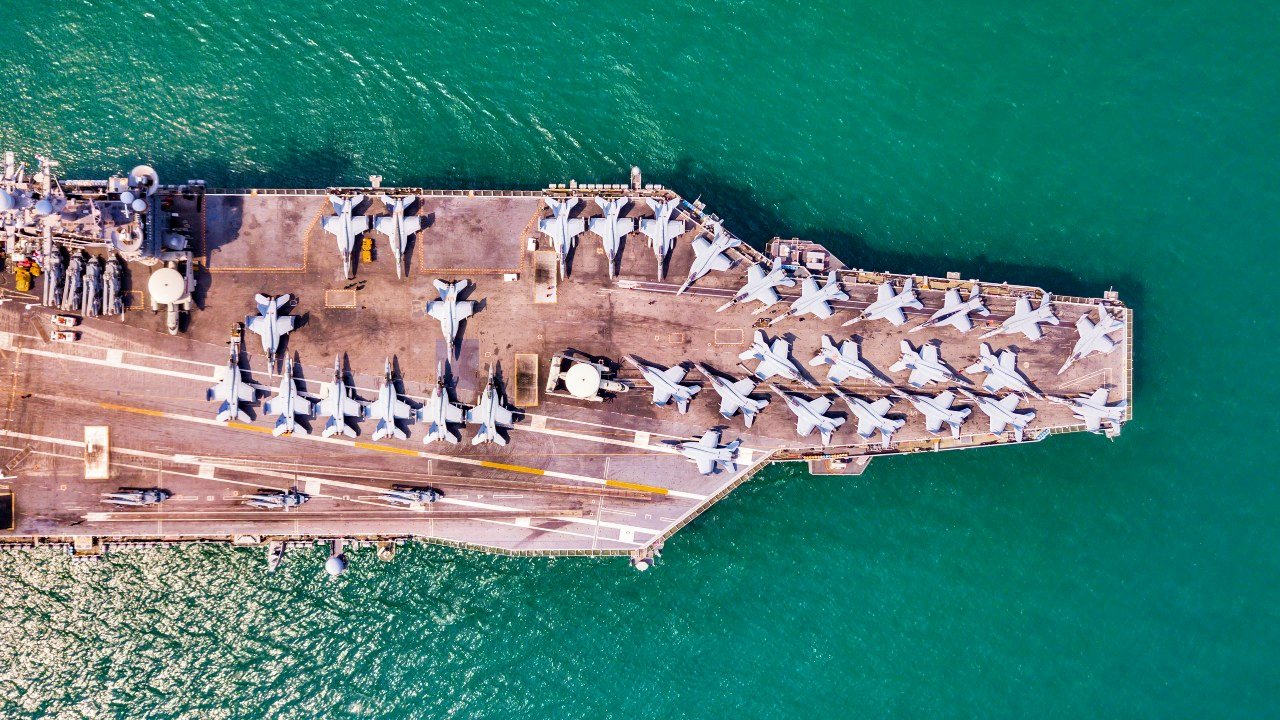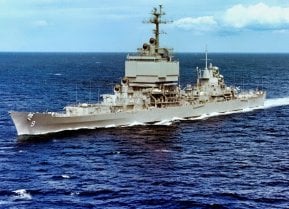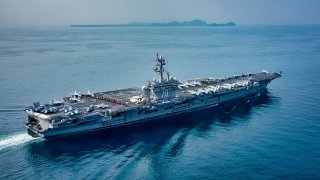5 Ways the Age of the Aircraft Carrier Could End
For 80 years, aircraft carriers have been central to the U.S. Navy's power projection, but their large size and operational costs now face scrutiny. New weapons could soon make the carrier obsolete.
Summary: The article discusses the evolving vulnerabilities of U.S. aircraft carriers amidst advancements in military technology by adversaries. For 80 years, carriers have been central to the U.S. Navy's power projection, but their large size and operational costs now face scrutiny. The emergence of unmanned underwater vehicles (UUVs), highlighted by a 2016 incident where China captured a U.S. Navy drone, signifies the rise of automated warfare. These drones pose significant threats due to their stealth and potential for offensive operations, challenging carriers in strategic waters. The article also covers the increasing risks from unmanned aerial vehicles (UAVs) and the deployment of "Carrier Killer" missiles by nations like China, aiming to neutralize carrier capabilities. The development of hypersonic weapons and nuclear threats further compounds the challenges faced by carriers. The piece concludes by questioning the future relevance of aircraft carriers in the face of these technological advancements and the pressing need for a strategic reassessment of their role in U.S. military strategy.
How the Age of the Aircraft Carrier Could End
They’re big. They’re slow. They’re hard to maneuver in a scrap. And they’re relatively easy to track. Yes, I’m talking about aircraft carriers. These floating airfields have been the centerpiece of the United States Navy’s offensive capability for 80 years.
Today, these platforms are larger and more complex than they’ve ever been. Yet, they are more vulnerable to America’s multiplying enemies—notably the People’s Liberation Army Navy (PLAN), China’s navy—and many are rightly questioning if their huge price tag and burdensome costs of upkeep are really worth it?
Unmanned Underwater Vehicle (UUV) Attack
The era of automated warfare has arrived. At the end of 2016, an extraordinary event occurred in the South China Sea. The US Navy was testing one of its unmanned underwater drones when a Chinese ship came by and scooped it up. They held the machine hostage for several days before finally giving it back.
But it was clear that the Chinese were interested in American UUV technology.
What’s more, given China’s sophisticated high-tech sector, and how the People’s Liberation Army (PLA) benefits greatly from China’s innovation hubs, the age of unmanned underwater drones—and the race to gain supremacy in this area—is only just beginning.
An underwater drone can be used for several important military missions. It can be used to passively gather data on enemy fleet movements. These systems could potentially help US and allied forces by doing real-time regional weather surveys. More importantly, though, these tiny undersea demons could be outfitted to carry high-yield explosives and hunt their unsuspecting prey down relentlessly until it reached that target to deliver its awful payload.
Interestingly, the US Navy and its allies are having to contend with this growing scourge in the Red Sea, as the Iranian-backed, Yemen-based Houthi Rebels have reportedly been deploying these unmanned systems against shipping in that region.

According to most naval experts, these UUVs “are inherently harder to detect and counter” for surface vessels. Therefore, the threat level to US carriers just increased. Certainly, carriers tend to travel in well-armed carrier groups. And carrier hulls are extremely difficult to penetrate.
At least on paper.
Although, the unique threat that UUVs pose, and their difficulty to both detect and intercept, mean that the threat to the safe operations of aircraft carriers in a contested region is real.
This threat is pronounced in geographically tight areas of responsibility, such as the Red Sea, Strait of Hormuz, or even the Taiwan Strait. Whatever Navy engineers may say about the inherent indestructibility of an aircraft carrier’s hull, no captain is going to want to test these claims in the real world.
Unmanned Aerial Vehicle (UAV) Assault
Unmanned Aerial Vehicles have been with us far longer than the aforementioned UUVs have been. Yet, their threat to an American flat top is similar to that of the UUV. In fact, the UUV and UAV can probably be deployed in tandem to swarm a targeted aircraft carrier, hitting her both from below the sea and above it simultaneously—likely swamping the sophisticated defenses of a targeted carrier (as well as its battle group).
Going back to the Middle East again, in the aftermath of the October 7 Iran-backed Hamas terrorist attacks against Israel, the United States took the unprecedented step of deploying two aircraft carriers to the region. The first, the brand-new Ford-class carrier, the USS Gerald R Ford, went to the Eastern Mediterranean. The other carrier, an older Nimitz-class, the USS Dwight D. Eisenhower, jogged over to the Arabian Gulf.
That carrier, operating in international waters that was close to Iranian territory, was subjected to a flyover by an Iranian military drone. Now, Iran’s drones (the design of which was copied from captured US military drones years before) are highly complex.
Despite the claims of invulnerability from official US Navy sources, there was a real threat to the safety of the Ike. The Iranian drone got within 1,500 yards of the carrier. This prompted a public rebuke of Iran from US Central Command (CENTCOM). It is likely that a carrier could handle one UAV.
But a swarm of them?
The UAV threat, like the UUV threat, is far too significant to ignore (which is why the Navy continues downplaying the threat in public. But America’s enemies are figuring this out).
“Carrier Killer” Missile Barrage
It’s not just about sinking an aircraft carrier. The engineers might just be right: the carrier would be exceptionally difficult to sink—especially from below. The carrier’s biggest threat to a rival military or country is its flight deck. The ability to deploy a massive number of powerful warplanes, have those warplanes return to the carrier, and then repeat as needed. That’s the thing that keeps enemy nations up at night when they fret over the prospect of US carriers operating near their shores.
China, Russia, Iran, and North Korea, have all developed what is known as anti-access/area denial (A2/AD) capabilities specifically designed to stunt the threat of US aircraft carriers. China has led these four nations in the quest to render America’s aircraft carrier fleet effectively obsolete. Possessing two versions of their so-called “Carrier Killer” missile platforms, the Dong-Feng 21D (DF-21D), which as a range of about 1,000 miles. A second, more advanced system has been fielded known as the Dong-Feng 26B (DF-26B), with a range of 2,600 miles. Any carrier in range of this system is likely to get its flight deck annihilated—meaning that it will be combat-ineffective.
And China has enough of these systems deployed to do this to multiple US flat tops.
It is believed that the DF-26B possesses an “active terminal seeker” which allows the long-range missile to track a moving target in real-time and keep up with that target. So, for all those who love to claim that an aircraft carrier is indestructible because of its ability to cruise along at 35 miles an hour, don’t get cocky.
What’s more, China has developed a sophisticated surveillance capability to track US warships, ranging from balloons permanently floating about places like the South China Sea that have installed on them sophisticated Huawei sensors. These sensors are attenuated to track the wakes of all vessels operating in the sea and then Chinese intelligence analysts can identify whether the wake is from a US warship or not.
On a more sophisticated level, China has an advanced remote sensing satellite that it has married to high-end artificial intelligence.
In the summer of 2021, China proved that this satellite system can track American aircraft carriers from their points of origin to their destinations. This artificial intelligence satellite could easily be tied to the DF-26B’s firing solution to assist the weapon in better tracking and successfully striking an American flat top, knocking out its flight deck (or sinking it), and creating a massive strategic hole in the US national defenses.
Hypersonic Weapon Attack Against an Aircraft Carrier
Russia leads the world in practical applications for hypersonic weapons. China is right behind them. Far behind these two autocratic regimes is the United States. Hypersonic weapons represent the greatest leap forward in offensive missile technology. Both Russia and China are developing strategic bombers that can fire hypersonic missiles. And that is a direct threat to any US aircraft carrier.
Hundreds of millions of dollars have been spent on ensuring that aircraft carriers can defend themselves against various anti-ship ballistic missile and cruise missile attacks. Hypersonic weapons throw all that out the porthole. A hypersonic weapon travels fast. But its speed is not what makes it a greater threat to a carrier than conventional missiles (which also travel fast). It’s the fact that hypersonic weapons travel along unpredictable courses.
This unpredictable maneuvering, as well as its speed, is what makes it possible—indeed, probable—that hypersonic missiles will catastrophically damage (or sink) US aircraft carriers.
There are currently no viable defenses against hypersonic weapons.
Nuclear Weapons
Lastly, there is the nuclear threat. An enemy might simply decide to lob a nuclear weapon at a carrier. China, Russia, Iran, and North Korea all have nuclear weapons capabilities to some degree. They might decide that the only way to end the carrier threat is to nuke the nearest one, after a shooting war with America commences. While carriers are well-defended against most conventional forms of attack, a nuke to a carrier would not end well for the carrier or its crew.


